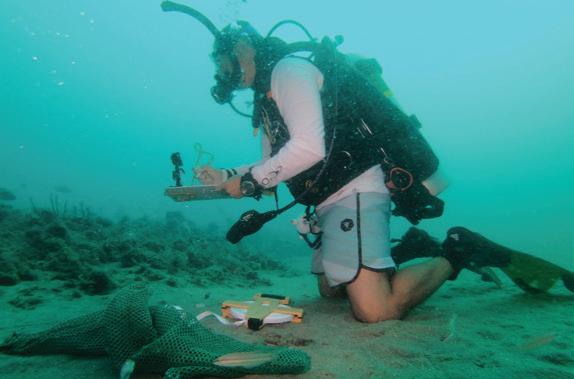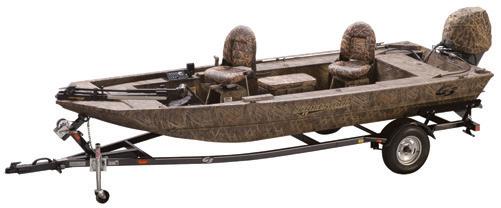
4 minute read
Around the Reef
By Ashley Misiaszek Grotewold
Advertisement
It’s that time of year for our annual Nancy Foster Research Expedition at Gray’s Reef and we are up to our gills in excitement. For starters, the director of all of America’s national marine sanctuaries, John Armor, dove with Gray’s Reef scientists for the first time since becoming director in 2016. John got a close-up view of a big loggerhead sea turtle, swam with thousands of fish, and observed scientists working underwater.
Equally exciting, the staff at Gray’s Reef was thrilled to have our new superintendent, Stan Rogers, join the expedition this year. In his first week, Stan was able to participate in one of the most important activities of the year, which will help inform him as he takes on his lead role at the sanctuary. More about Stan will be coming in next month’s column.
The Nancy Foster Expedition is critical to ongoing study of the special place that is Gray’s Reef. This year’s expedition was no exception, as hundreds of dives were conducted during the 12-day mission (July 29-Aug. 9).
A range of exciting and innovative operations took place both in and out of the sanctuary’s research area (RA). The RA is designated for scientists to study the sanctuary’s unique underwater habitat without effects from human actions. It encompasses the southern third of the sanctuary, about eight square miles.
Each year the expedition utilizes NOAA Ship Nancy Foster, a large research vessel, as a science platform; hence the name. The projects explore questions related to fish abundance and distribution, the structural habitat of Gray’s Reef, invertebrate assessments, habitat mapping, algae diversity, and the microbial communities that live symbiotically with the reef’s resident corals.
Kimberly Roberson, the research coordinator and unit dive supervisor for Gray’s Reef, serves as the chief scientist for this year’s mission. Along with Dr. Roldan Muñoz of NOAA Fisheries, Kim collected ongoing data to study the Gray’s Reef’s community. They focused on two different subject areas: one being fish abundance, diversity and distribution, the other being habitat characteristics such as ledge height and width. Studying the community and structure of Gray’s Reef will help the sanctuary superintendent protect and preserve the abundant marine life that lives within its waters.
Since Gray’s Reef is referred to as a “live bottom reef” for its vast diversity of marine life, one study was especially crucial during these research efforts. Dr. Daniel Gleason and students from Georgia Southern University documented the abundance and diversity of the invertebrate communities and their populations within Gray’s Reef. Known as sessile benthic invertebrates, these animals cover the reef’s floors and ledges, leaving the sanctuary literally crawling with life. “Sessile” refers to organisms that are fixed in one place, “benthic” occurs on or near the bottom of a body of water, and “invertebrates” are creatures that do not have a backbone, like sponges, corals, and algae. Understanding the reef’s invertebrates is critical for more reasons than just being an important part of our reef’s natural food chain. For example, sponges and mussels filter the water within Gray’s Reef, while corals provide a secure place for eggs to hatch while fish hide from predators.
The Nancy Foster Expedition has helped scientists develop metrics to understand and enhance the natural resources of Gray’s Reef for future generations. We are very excited to utilize this year’s research to further guide us in our preservation and protection of Gray’s Reef National Marine Sanctuary. We look forward to applying new discoveries to support and manage our sanctuary, while continuing to learn how we at Gray’s Reef play our part in this wonderous oceanic world.

For more information, email: michelle.riley@noaa.gov or call (912) 598-2345
Top of page: Dr. Roldan surveying fish during a research project at Gray's Reef. Photo by Harrison Franklin
Left: Cubbyu surround divers during the annual Nancy Foster Expedition. Photo by Alison Soss
I’ve fetched this GREAT motor for you!

Good food and good fun - for the whole family!

Live bait Dockage Dry Storage
Fish Tales 727.3473 • Ft. McAllister Marina 727.2632 3203 Ft. McAllister Road • Richmond Hill, GA • SM 605 Get out on the water with one of our Mercury Re-powers!
2604 Causton Bluff Road • Savannah, GA (912) 376-8776 • HaleMarineInc@gmail.com


Satilla Marine
Family Owned and Operated Since 1977



Parts and Service - Boats - Trailers - Outboards Accessories - Boat Gear - Rods - Reels - Tackle Serving all of coastal and south Georgia for your shing and boating needs! 1807 Old Reynolds Street • Waycross, GA • (912) 285•8115 • sales@satillamarine.com










